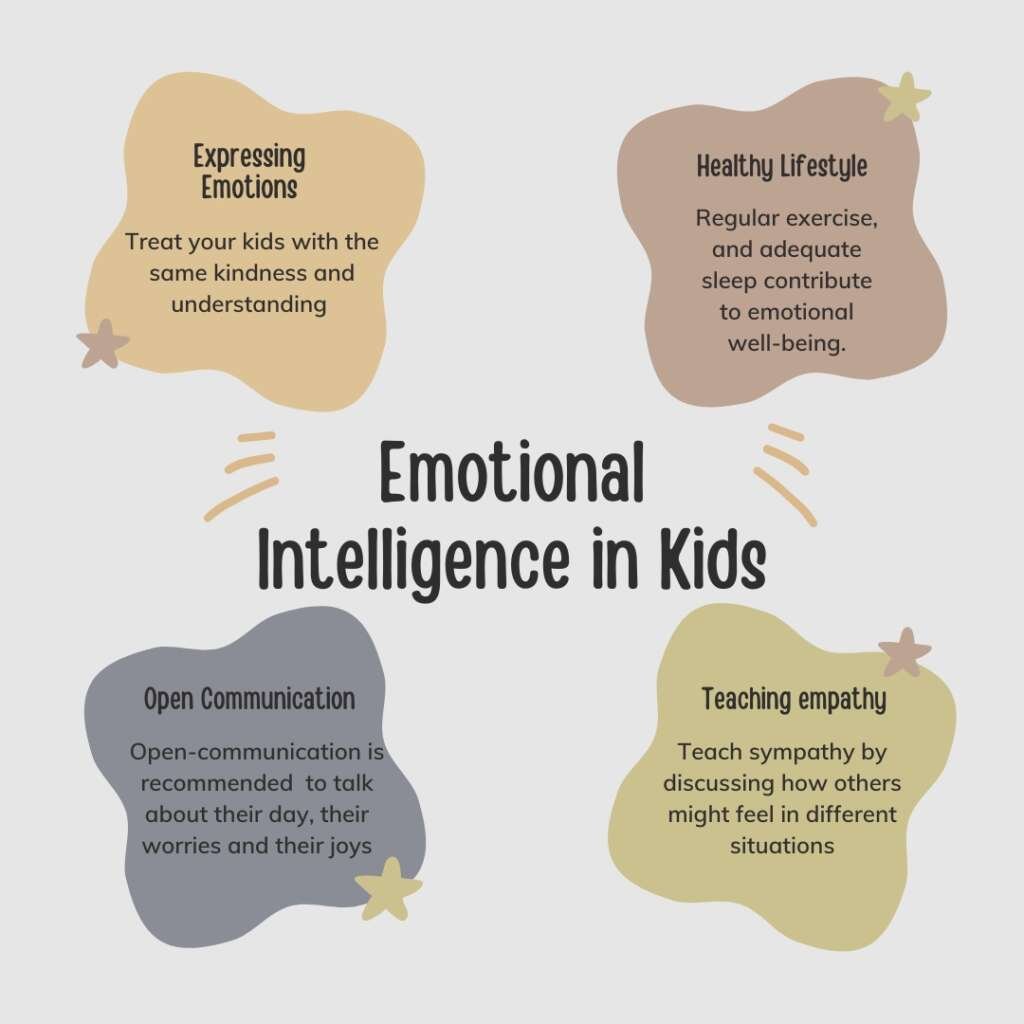Good moms always help their kids to get the right picture about their feelings and how to express their feelings to others. Emotional intelligence is recommended to help kids for managing their emotions, build strong relationships and solve problems.
Here in this blog we will explore some outstanding ways that moms can teach their children by showing empathy. Moms can help their kids to grow by nurturing emotional intelligence. Let’s get into the blog to know how do good moms build emotional intelligence in their kids.

Expressing Emotions
Moms should know how to express their feelings to teach their kids about emotions. When a mom shares her own experiences to her children shows that everyone has feelings and it’s normal to talk about them. For example, if she’s had a tough day, she might say, I felt really overwhelmed today but talking about it helped me feel better.
Seeing their mom handling her feelings help children learn how to identify their own emotions and find words to describe them. When moms express emotions, they create a safe space where kids can learn to navigate their feelings and develop strong emotional intelligence.
Promote Open Communication
Creating a safe space for children for meaningful conversation with kids is recommended. Good moms follow their kids to talk about their day, their worries and their joys. This helps kids learn to express themselves effectively.
When children become familiar with what they can share everything without fear of being judged, they feel more confident in opening up. Moms can get started with conversations by asking simple questions like, “What was the best part of your day?” or “Did anything make you feel sad today?”

Here are some practical tips to enhance this communication:
Set Aside Regular Time for Talks: Designate a specific time each day such as during dinner or before bed for open conversations with kids. This routine helps kids know they have dedicated time to share and discuss their feelings.
Use Flexible Questions: Deeper conversations go well instead of yes or no questions like “what was something interesting that happened today?” or “How did that make you feel?”
Create a Comfortable Environment: Choose a quiet comfortable place to talk, free from distractions like screens. A cozy setting can make kids feel more at ease sharing their thoughts.
Practice Active Listening: Show genuine interest by maintaining eye contact, nodding and repeating back what kids say to demonstrate understanding. For example, ”So you felt really excited when you scored highest in exam?
Teaching empathy
Moms can help kids to teach sympathy by discussing how others might feel in different situations. Ask questions like, ”How do you think your friend felt when that happened?” promotes children to consider other people’s perspectives. This practice teach kids to step into someone else’s shoes and fostering compassion. Here are some practical tips to enhance empathy in children:
Use Real-Life Examples: Share relatable stories from your own life or current events that explain different emotions. Ask your child how they think the people involved felt, prompting them to analyze this situation.
Incorporate Books and Movies: Choose books and movies with rich characters and emotional scenarios. After reading or watching discuss the characters’ feelings and choices. Questions like, “What do you think she was feeling when that happened?” can start meaningful conversations.
Role-Playing Activities: Engage in role-playing games where your child can observe different scenarios. For example, they can pretend to be a friend who is feeling left out and think about how to comfort them. This helps them understand and dealing emotions.
Helping with Problem-Solving
When conflicts arise rather than stepping into solve them, good moms guide their children through the problem-solving process. This approach teaches kids to think critically and consider different solutions, strengthening their emotional regulation skills.
Promoting kids to reflect on past conflicts and how they resolved them can also be beneficial. When children learn to deal disagreements on their own, they develop resilience which are important for their emotional growth. Here are some practical tips to help children for problem-solving effectively:
Ask Questions: Go for open-ended questions that encourage critical thinking. For example, “What do you think you could do to resolve this?” or “What are some choices you have in this situation?”
Discuss Pros and Cons: Guide your child with several results to evaluate each option by discussing the pros and cons. This helps to consider the potential results of their choices and evaluate the impact on others.
Model Problem-Solving: Share your own problem-solving experiences with your child. Discuss challenges you have faced and how you approached finding a solution.
Use Visual Aids: Create visual aids for problem-solving. Include prompts for each step such as identifying the problem, brainstorming solutions and evaluating outcomes. This will be a helpful guide for your child.
Validating Feelings
Acknowledging and validating a child’s emotions is important. When a child feels sad or angry, a good mom listens and reassures them that it’s alright to feel that way. This validation helps children understand their emotions betters. Here are some practical tips to enhance the process of validating feelings:
Use Thoughtful Listening: Paraphrase what your child is saying to show you understand. For example, if they say, “I’m so mad” you might respond, “You’re really upset right now.” This confirms their feelings to share more.
Normalize Emotions: Always ensure your child that all emotions are natural and everyone experiences them. You might say, “Its okay to feel frustrated; everyone gets frustrated sometimes.”
Express the feelings: Invite your child to express their feelings in words, art or play. Ask them to draw how they feel or create a story about their emotions. This helps them to clear their feelings in different ways.
Follow-Up: Check in with your child later about their feelings. This shows them that their emotions matter and that you care about their well-being.
In a Nutshell
We all know how much it’s important to build child emotional intelligence in kids is a journey that requires patience and practice. Good moms play an essential role by modeling behaviors, encouraging communication and providing support. With all these tips, children can develop the emotional skills they need to thrive in life for their future.


